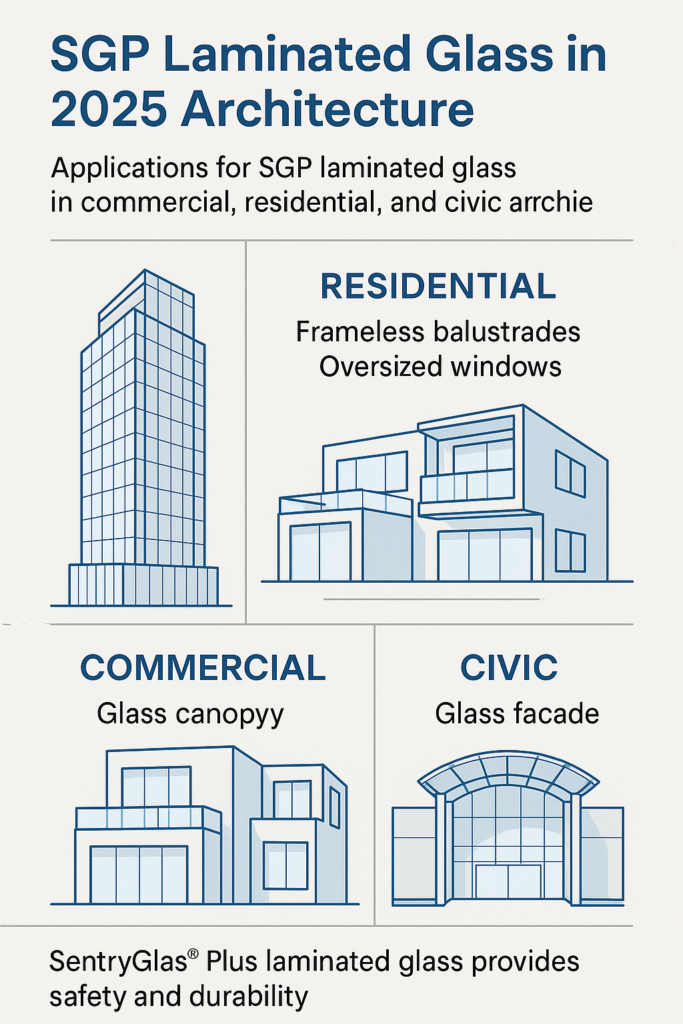In 2025, modern architecture is defined by a mix of minimalism, sustainability, and structural transparency. With the growing demand for open visual spaces, clean lines, and extreme durability, SGP laminated glass continues to dominate the materials palette for architects and developers. Unlike traditional glass types, SGP laminated glass offers a balance of aesthetics and safety that aligns with both form and function in contemporary construction.
This article explores how SGP laminated glass in architecture is evolving with the latest design trends, where it’s most commonly used, and why it’s the material of choice for iconic buildings worldwide.
What Is SGP Laminated Glass and Why Architects Use It
SGP laminated glass is made by bonding glass panels with an ionoplast interlayer (SentryGlas® Plus). This interlayer is:
- Five times stronger than traditional PVB
- One hundred times stiffer
- UV and moisture resistant
- Clearer and longer-lasting
The material is favored for architectural designs requiring structural safety, optical clarity, and minimal framing. It’s ideal for curtain walls, railings, skylights, and façades.
To understand key differences between interlayers:
🔗 When to Choose SGP Laminated Glass Over PVB
Top Trends in SGP Laminated Glass for 2025
1. Frameless Transparency with Load Support
Designers are increasingly using SGP glass to eliminate bulky support frames. In 2025, the trend is toward:
- Point-fixed systems for glass walls
- Structural glass fins for multi-story façades
- Cantilevered balconies with no top rail
The rigidity of the SGP interlayer allows for clean, frameless designs with built-in safety.
2. High-Rise Integration for Safety and Clarity
With cities building higher than ever, SGP laminated glass is the solution for:
- Wind-resistant glass façades
- Post-breakage load retention
- Balcony safety glass on towers
- Floor-to-ceiling panels in skyscrapers
Its strength meets international building codes for high-rise structures.
3. Sustainability and Energy Efficiency
As buildings chase LEED and WELL certification, SGP laminated glass is now:
- Paired with Low-E coatings in IGUs
- Used in energy-efficient curtain walls
- Designed with solar control performance
- Built into natural daylighting strategies
The glass contributes to passive solar design while maintaining a minimal carbon footprint.
4. Acoustic and Privacy Integration
In mixed-use spaces, glass must offer more than just visibility. The 2025 trend includes:
- Laminated acoustic SGP glass for hotels and offices
- Switchable or tinted interlayers for smart glass functionality
- Sandwiched films for gradient or decorative effects
SGP supports all these advancements due to its structural bonding capacity and optical compatibility.
5. Safety + Style in Public and Commercial Use
SGP laminated glass is found in:
- Transportation hubs
- Civic centers
- Museums and galleries
- Retail storefronts
It adds elegance while meeting demanding safety regulations and design expectations.
Need sourcing help?
🔗 SGP Laminated Glass: Best Manufacturers & Suppliers Guide
Where Is SGP Laminated Glass Commonly Applied?
Here are the top applications architects are using in 2025:
- Curtain walls: Structural strength, edge clarity
- Balustrades: Frameless safety for balconies and stairs
- Overhead glazing: Skylights and glass canopies
- Flooring: Walkable glass with anti-slip coatings
- Partitions: Sleek interior glass walls
- Outdoor barriers: Pool fences, rooftop enclosures
Each application benefits from the clarity, rigidity, and weather resistance of SGP.
Explore more use cases:
🔗 Where Is SGP Laminated Glass Commonly Used?
2025 Material Pairings with SGP Laminated Glass
To enhance performance, architects are combining SGP glass with:
- Low-iron glass for optical clarity
- Low-E coatings for thermal efficiency
- Ceramic frits for sun shading
- Anti-reflective coatings for glare reduction
- Smart film interlayers for digital displays or tint-on-demand
These additions create glass that adapts to the function and environment of any modern building.
Maintenance and Lifecycle Performance
SGP laminated glass requires minimal maintenance due to:
- Hydrophobic edge resistance
- UV durability
- Post-breakage integrity
- Long-term clarity with reduced yellowing
It outlasts PVB options and reduces long-term repair or replacement costs—especially in outdoor and high-elevation applications.
Design and Cost Considerations
While the sgp laminated glass price is typically 30–50% higher than PVB laminated options, its benefits include:
- Fewer framing materials needed
- Longer lifespan
- Enhanced performance
- More expansive design freedom
Architects and developers increasingly see this as a long-term investment in safety and sustainability.
Why 2025 Is the Year of SGP in Architecture
- Building codes favor safety and structural resilience
- Designers want maximum glass and minimal steel
- Occupants want daylight without heat gain
- Developers want longevity and ROI
- Cities want transparent, elegant skylines
SGP laminated glass checks all these boxes and supports visionary design.
Conclusion
In 2025, SGP laminated glass isn’t just a material—it’s a modern design strategy. Its strength, clarity, and adaptability make it indispensable for architects aiming to create safe, functional, and beautiful spaces.
From glass towers to frameless balconies and energy-efficient façades, SGP is redefining the role of glass in architecture.
To take your knowledge further:
🔗 When to Choose SGP Laminated Glass Over PVB
🔗 SGP Laminated Glass: Best Manufacturers & Suppliers Guide
🔗 Where Is SGP Laminated Glass Commonly Used?

